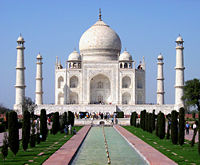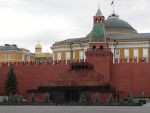Mausoleum
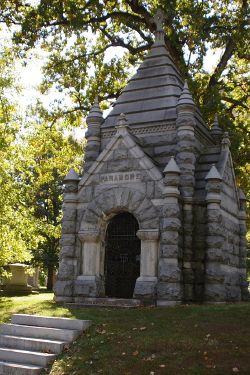
A mausoleum (plural: mausolea) is an external free-standing building constructed as a monument enclosing the interment space or burial chamber of a deceased person or persons. A mausoleum may be considered a type of tomb or the tomb may be considered to be within the mausoleum. A Christian mausoleum sometimes includes a chapel.
Etymology
The word derives from the Mausoleum of Maussollos (near modern-day Bodrum in Turkey), the grave of King Mausollos, the Persian satrap of Caria, whose large tomb was one of the Seven Wonders of the Ancient World.
Description
Origin
Historically, mausolea were, and still may be, large and impressive constructions for a deceased leader or other person of importance. However, smaller mausolea soon became popular with the gentry and nobility in many countries, particularly in Europe and her colonies during the early modern and modern periods. These are usually small buildings with walls, a roof and sometimes a door for additional interments or visitor access. Single mausolea may be permanently sealed. A mausoleum encloses a burial chamber either wholly above ground or within a burial vault below the superstructure. This contains the body or bodies, probably within sarcophagi or interment niches. Modern mausolea may also act as columbaria (a type of mausoleum for cremated remains) with additional cinerary urn niches. Mausolea may be located in a cemetery, a churchyard or on private land.
Notable mausolea
Nizami Mausoleum
The Nezami Mausoleum, built in 1991 in honor of Nezāmī Ganjavī, stands just outside the city of Ganja, Azerbaijan. It is a tall cylindrical building, surrounded by gardens. To one side, there is a metal statue commemorating Nezami's epic poems.
China

Of all the mauslea in China, (Ancient Tombs at Longtou Mountain, Mausoleum of Princess Zhenxiao, Mausoleum of the First Qin Emperor, Xi'an, Mausoleum of Genghis Khan, Inner Mongolia, Thirteen Imperial Mausoleums of Ming Dynasty Emperors, Beijing, Ming Xiaoling Mausoleum, Nanjing, Sun Yat-sen Mausoleum, Nanjing, Zhao Mausoleum, Jiuzong mountain, Shaanxi province) the most famous perhaps is the Mausoleum of Mao Zedong, Beijing, Tiananmen Square.
The Chairman Mao Memorial Hall (Chinese: 毛主席纪念堂; pinyin: Máo Zhǔxí Jìniàntáng), commonly known as the Mausoleum of Mao Zedong, or the Mao Mausoleum, is the last resting place of Mao Zedong, Chairman of the Politburo of the Communist Party of China from 1943 and the chairman of the Central Committee of the Communist Party of China from 1945 until his death.
Although Mao had wished to be cremated, his body was embalmed, and construction of a mausoleum began shortly after his death. This highly popular attraction is located in the middle of Tiananmen Square, in Beijing, the capital of China. On this site had previously stood the Gate of China, the southern (main) gate of the Imperial City during the Ming and Qing dynasties.
The remains of the Great Helmsman, as he is sometimes known, are on display for public viewing. People queue up for hundreds of metres every day to see the former chairman, many paying tribute to him with flowers that can be rented at the entrance on the north side. There is a souvenir shop at the exit on the south side.
Finland
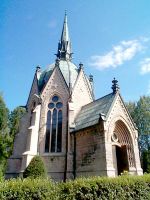
The Juselius Mausoleum, in the city of Pori.The Neo-Gothic Juselius Mausoleum, located in the Käppärä cemetery in central Pori, was built in 1903 by the wealthy industrialist F.A. Juselius for his daughter Sigrid who died when she was only 11 years old. The Mausoleum was designed by the architect Josef Stenbäck. The Mausoleum originally had frescoes painted by artist Akseli Gallen-Kallela, but these decayed after a short time. The frescoes were restored by Akseli's son Jorma Gallen-Kallela using his father's sketches.
India
The Tāj Mahal is a mausoleum located in Agra, India. The Mughal emperor Shāh Jahān commissioned it as the final resting place for his favorite wife, Mumtaz Mahal. Construction began in 1632 and was completed in 1648.
The Taj Mahal is considered by many to be the finest example of Mughal architecture, a style that combines elements of Persian and Indian styles. Some dispute surrounds the question of who designed the Taj. A team of designers and craftsmen were responsible for the design, with the Persian architect Ustad Isa usually considered the most likely candidate as the principal designer. While the white domed marble mausoleum is the most familiar part of the monument, the Taj Mahal is actually an integrated complex of structures.
Shah Jahan intended the Taj Mahal to be acclaimed by the entire world, and since its construction the building has been the source of an admiration that has transcended cultures and geography. Personal and emotional responses to the building have consistently eclipsed the scholastic appraisals of the monument. The poet Rabindranath Tagore, a Nobel laureate, called Taj Mahal "a drop of tear on the cheek of history."
Iran
Iran's Cultural Heritage Organization lists several hundred mausoleums in Iran. (See Ferdowsi and Ziyarat articles for some examples). Many such as Imam Reza Mausoleum in Mashhad are religious and from bygone eras. Some, such as the mausoleum of Cyrus the great carry national significance, and others, such as the Imam Khomeini mausoleum in Tehran are contemporary and carry more political weight.
Sheikh Abd al-Samad Esfahani (شیخ عبد الصمد اصفهانی) was a famous Ilkhanid era Sufi of the 13th century.
After his death, a shrine was built in Natanz to honor the Sheikh by the Sheikh's disciple, the Ilkhanid vizier Zain al-Din Mastari.
He reportedly died in 1299C.E. in Natanz.
Israel
]]
The 'tomb' known today as Yad Avshalom (Avshalom's Monument - יד אבשלום) is located in the Kidron Valley in Jerusalem, situated between the Temple Mount and Mount of Olives.
Archaeologists have dated the 'tomb' to the first century CE. It is believed to be the 'tomb' of Absalom. It may contradict 2 Samuel 18:17 which says Absalom's body was covered over with stones in a pit in the forest of Ephraim.
The Jewish tradition connects it to Absalom son of King David. According to 2 Samuel 18:18, "Absalom in his lifetime had taken and reared up for himself a pillar, which is in the king's dale: for he said, I have no son to keep my name in remembrance: and he called the Monument after his own name: and it is called unto this day, Absalom's Monument.
The people of Jerusalem, for centuries, used to come to this monument with their children and stone it - to show children what happens to sons who disobey their parents.
According to a local legend, Napoleon fired a mortar at the tomb and removed the shape of a hand that topped the conical roof. The legend continues that he was angry at Absalom for rebelling against his father, David. It is known however that Napoleon never reached Jerusalem during his campaign in the Holy Land.
A Muslim tradition connects it to the Pharaohs - hence the Arabic name "Pharaoh's Hat".
Pakistan
National Mausoleum of Pakistan (Mausoleum of the founder of Pakistan- Muhammad Ali Jinnah), Karachi City
Mazar-e-Quaid (Urdu: مزار قائد) or the National Mausoleum refers to the tomb of the founder of Pakistan, Muhammad Ali Jinnah. It is an iconic symbol of Karachi throughout the world. The mausoleum is situated at the heart of the city, completed in 1960s.
Structure
The mausoleum is made of white marble with curved Moorish arches and copper grills rest on an elevated 54 square meters platform. The cool inner sanctum reflects the green of a four-tiered crystal chandelier gifted by the people of China. Around the mausoleum there is a park fitted with strong beamed spot-lights which at night project light on the white mausoleum. The location is usually calm and tranquil which is significant considering that it is in the heart of one of the largest global megalopolises. The glowing tomb can be seen for miles at night. Liaqat Ali Khan, the first Prime Minister of Pakistan, and Jinnah's sister, Mohtarma Fatima Jinnah, are also buried besides Jinnah.
Official and military ceremonies take place here on special occasions, such as:
- National commemoration days, especially Pakistan Day (23 March), Independence Day (14 August).
- Birth and death anniversaries of Quaid-e-Azam Muhammad Ali Jinnah, 25 December and 11 September respectively, and
- Birth (30 July) and death (8 July) anniversaries of Madar-e-Millat Fatima Jinnah.
Dignitaries and officials from foreign countries also visit this place. The Mazar-e-Quaid has been officially recognized as the National Mausloeum of the country.
Russia
Lenin's Mausoleum (Russian: Мавзолей Ленина Mavzoley Lenina) also known as Lenin's Tomb, situated in Red Square in Moscow, is the mausoleum that serves as the final resting place of Vladimir Lenin. His embalmed body has been on public display there since the year he died in 1924 (with rare exceptions in wartime). Aleksey Shchusev's diminutive but monumental granite structure incorporates some elements from ancient mausoleums, such as the Step Pyramid and the Tomb of Cyrus the Great.
On January 21, the day that Lenin died, the Soviet government received more than 10,000 telegrams from all over Russia, which asked the government to preserve his body somehow for future generations. On the morning of January 23, Professor Alexei Ivanovich Abrikosov—a prominent Russian pathologist and anatomist (not to be confused with physicist Alexei Alexeyevich Abrikosov, his son)— embalmed Lenin's body to keep it intact until the burial. On the night of January 23, architect Aleksey Shchusev was given a task to complete within three days: design and build a tomb to accommodate all those who wanted to say their goodbyes to Lenin. On January 26, the decision was made to place the tomb at the Red Square by the Kremlin Wall. By January 27, Shchusev built a tomb out of wood and at 4 p.m. that day they placed Lenin's coffin in it. More than 100,000 people visited the tomb within a month and a half. By August of 1924, Shchusev upgraded the tomb to a bigger version. The architect Konstantin Melnikov designed Lenin's sarcophagus.
Turkey
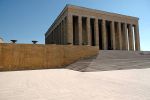
Kemal Atatürk's Mausoleum, Ankara, Turkey
Anıtkabir (literally, "memorial tomb") is the mausoleum of Mustafa Kemal Atatürk, the leader of Turkish War of Independence and the founder and first president of the Republic of Turkey. It is located in Ankara and was designed by architects Professor Emin Onat and Assistant Professor Orhan Arda, who won the competition held by the Turkish Government in 1941 for a "monumental mausoleum" for Atatürk out of a total of 49 international proposals.
The site is also the final resting place of İsmet İnönü, the second President of Turkey, who was interred there after he died in 1973. His tomb faces the Atatürk Mausoleum, on the opposite side of the Ceremonial Ground.
Architectural properties
The period of Turkish architecture between 1940 and 1950 has been classified by architectural historians as the Second National Architecture Movement. This period is characterized mostly by monumental, symmetrical, cut-stone clad buildings, with great emphasis given to detailing and workmanship in construction. Anıtkabir contains the same characteristics of this period, and is considered by many to be the ultimate monument of the era. In addition, Anıtkabir features Seljuq and Ottoman architectural and ornamentation features. For example, the eaves of the towers and the Hall of Honour are all Seljuq-style sawtooth ornamentation.
Uzbekistan
Samanid mausoleum Bukhara.
The Samanid mausoleum is located in the historical urban nucleus of the city of Bukhara, in a park laid out on the site of an ancient cemetery. This mausoleum, one of the most esteemed sights of Central Asian architecture, was built in the 9th (10th) century (between 892 and 943) as the resting-place of Ismail Samani - the founder of the Samanid dynasty, the last Persian dynasty to rule in Central Asia, which held the city in the 9th and 10th centuries. Although in the first instance the Samanids were Governors of Khorasan and Ma wara'u'n-nahr under the suzerainty of the Abbasid Caliphate, the dynasty soon established virtual independence from Baghdad.
For many years the lower part of the mausoleum remained under a two-meter high layer of sediment. Now the foundation has been cleared of these obstacles and the mausoleum, fully restored, is open for observation from all sides as was initially planned by the builders.
The monument marks a new era in the development of Central Asian architecture, which was revived after the Arab conquest of the region. The architects continued to use an ancient tradition of baked brick construction, but to a much higher standard than had been seen before. The construction and artistic details of the brickwork (see picture), are still enormously impressive, and display traditional features dating back to pre-Islamic culture.
External links
Credits
New World Encyclopedia writers and editors rewrote and completed the Wikipedia article in accordance with New World Encyclopedia standards. This article abides by terms of the Creative Commons CC-by-sa 3.0 License (CC-by-sa), which may be used and disseminated with proper attribution. Credit is due under the terms of this license that can reference both the New World Encyclopedia contributors and the selfless volunteer contributors of the Wikimedia Foundation. To cite this article click here for a list of acceptable citing formats.The history of earlier contributions by wikipedians is accessible to researchers here:
The history of this article since it was imported to New World Encyclopedia:
Note: Some restrictions may apply to use of individual images which are separately licensed.
